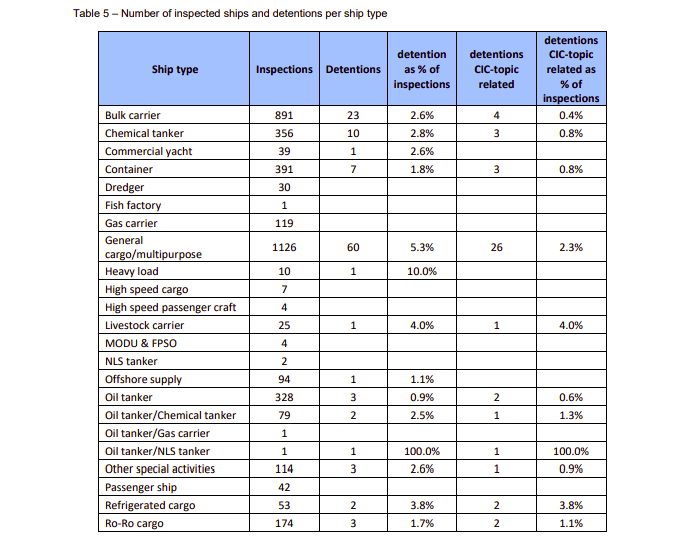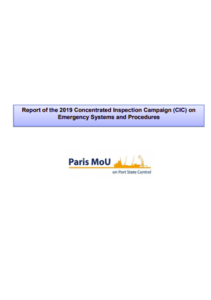Paris MoU issued its official report on the 2019 Concentrated Inspection Campaign (CIC) on Emergency Systems and Procedures. A total of 48 ships were detained as a direct result of the CIC.
It is concerning that during the CIC, 526 deficiencies were recorded, related specifically to Emergency Systems and Procedures and that 48 ships were detained as a result of the CIC, the Paris MoU report on CIC stresses.
The results show that there is generally a satisfactory overall compliance with the provisions of the SOLAS requirements covered by the scope of this CIC, considering the number of deficiencies recorded,
…the report reads.
It is however of concern to note that older ships have a higher detention percentage, since it indicates a lower level of compliance/preparedness and functioning of equipment in case of emergencies, where the crew will be subjected to a higher risk.
CIC 2019 in numbers
- The Questionnaire was completed on a total of 4,009 ships.
- A total of 48 ships were detained as a direct result of the CIC.
Whilst the detention rate appears low (1.2%) it has to be borne in mind that a detention was not always considered to be appropriate. Depending on the situation and taking into account all the circumstances of the planned voyage, it is possible to agree on appropriate remedial action without detaining the ship.
- In 6.6% of cases (120) a fire drill and/or abandon ship drill, when witnessed, was not satisfactory and in 4.5% of cases (48) the accumulator batteries and switchboard, if the emergency source of power, were not in good condition.
- In 4.4% of cases (172) for ships with water level detectors installed, the system and alarm arrangements were not operational.
- A total of 833 inspections (20.8% of the total of CIC inspections) had one or more CIC related deficiencies recorded. The most common deficiency was related to “Muster List”, which was recorded in 201 cases, followed by “Emergency lighting, batteries and switches” 169 cases and “Public address system”109 cases.

- By ship risk profile, the CIC-topic related detention rate is 4.5% for High Risk Ships, 1% for Standard Risk Ships and 0% for Low Risk Ships. Ships with an Unknown Ship Risk Profile accounted for 1.1% of the CIC topic related detentions. As would be expected from the risk profiling system of the Paris MoU, the High Risk Ships showed by far the highest detention rate and CIC-topic related detention rate during the CIC campaign.
- Livestock carriers had the highest CIC-topic related detention rate (4.0%, 1 detention), followed by refrigerated cargo ships (3.8%, 2 detentions) and general cargo/multipurpose ships (2.3%, 26 detentions).

- By ship age the CIC-topic related detention rate increases from 0.2% for ships with an age of 5 years or less to an average of 0.4% for ships with an age between 5 and 15 years to an average of 5.1% for ships with an age between 31 and 35 years.
- By flag state: During the campaign ships flying the flag of 89 different countries have been inspected. 49 flag states (55%) did not have any CIC-topic related detentions. Of those that did, the highest number of ships detained were Panama (22), followed by Malta (8), Antigua & Barbuda (6), Liberia (6), Portugal (6), Marshall Islands (5) and Togo (5).
- The highest percentage of ships detained however was Egypt (40%), Saint Kitts and Nevis (33.3%), Tuvalu (33.3%), the Republic of Moldova (21.1%), Palau (15.4%), and Togo (12.5%). Egypt and Tuvalu are on the Paris MoU Grey list, whereas the other countries are on the Paris MoU Black list.
- In addition, 8 CIC-topic related detentions have been recorded with RO responsibility attributed.
Recommendations
It is recommended that PSCOs continue to look at Emergency Systems and Procedures during PSC inspections and take appropriate action.
Although in general the CIC showed that there is a satisfactory level of compliance with the requirements related to Emergency Systems and Procedures, the CIC also showed that there are specific areas where a higher level of non-compliance exists;
- fire drill
- abandon ship drill and
- in the area where the emergency source power is an accumulator battery.
A continued focus on improvement, especially in these areas, is required by both ship owners and crews, as well as port State control.
Explore more herebelow:





























































